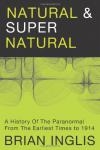
Inglis was a prolific author on the paranormal, and as a professional journalist as well as a historian his books are always readable and informative. Natural and Supernatural brought together a wealth of material that had previously been scattered in specialist publications and made it available to a wide audience. It runs chronologically through the following periods, from which it can be seen that a huge amount of compression has gone on to fit the subject into 500 pages: ‘Tribal communities’; ‘Early civilisations’; ‘Christianity’; ‘From the Renaissance to the Age of Reason’; ‘Mesmerism’; ‘Spiritualism’; ‘Psychical research’; ‘The Society for Psychical Research’; ‘Psychical research in decline’; and ‘The unknown guest’ (i.e. concluding remarks).
As the chapter headings indicate, the book has a broad historical sweep, and it tracks the ways that claims of ‘paranormal’ phenomena have been interpreted within diverse belief systems. Inglis also examines differences among psychical researchers in deciding between explanations involving spirit communication, and psi processes emanating from the living. The Society for Psychical Research plays a major role in the later chapters but Inglis is not always kind to it, seeing some of its members – notably Richard Hodgson and Frank Podmore – as having fostered a critical climate inimical to the fair discussion of psychic claims, and having not only failed as an organisation to counter its subject matter’s opponents, but actually often being in sympathy with them.
The key question is whether Natural and Supernatural holds up nearly forty years after its first appearance. The answer is yes, it does, though it needs to be treated cautiously. Inglis has his biases, which he is not shy about displaying, and while for example he concedes that mediumship has had some fraudulent activity, he is firmly convinced that by and large its physical phenomena were genuine and we can generally rely on the contemporary accounts of them. His standard approach is to confront the reader with the sheer volume of cases, and suggest that the evidence is sound because of its consistency and cumulative effect. The critic will naturally retort that an accumulation of nonsense is still nonsense, or more charitably that much that is not accounted for by fraud can be attributed to the psychological processes that have been gathered in recent years under the umbrella of Anomalous Psychology.
The readership may therefore divide into three sections: those who agree with Inglis that an explanation which posits widespread fraud and misperception is even more unlikely than the paranormality of the phenomena that are described; those who marvel that so much deception and self-deception can be taken this seriously, believe that Inglis lets some dubious practitioners off the hook rather easily, and conclude that he is too ready to accept historical records when we cannot vouch for their accuracy at this distance; and those holding a middle position who feel that there may be something in some of it, but that Inglis frequently overstates his case. While the reader may not necessarily be in sympathy with Inglis’s views, that does not detract from the usefulness of his historical synthesis. Much scholarship has been focused on these matters since the late 1970s, but Natural and Supernatural’s wide range and accessibility means that it is still of value as a starting point for further exploration.
A note on editions: the White Crow Books reissue has a new introduction by Inglis’s son Neil L. Inglis which gives an affectionate overview of his father’s career and the development of his interest in the paranormal. Neil is candid about bias in Natural and Supernatural (or ‘a clear authorial point of view’ as he delicately puts it). However, Brian’s text has not been thoroughly edited to correct errors. More of an issue is the fact that it is based on the 1977 Hodder and Stoughton edition, and not the one that was published by Prism in 1992. For some reason the first edition omitted the references, and these were reinstated in the Prism reissue, amounting to an extra 19 pages. As White Crow have used the original edition as the basis for theirs, the references have disappeared again. While this is fine for the general reader, those who wish to follow up the sources in more detail may prefer to find a second-hand Prism copy. Even with this caveat, it’s good to see it back in print.
A review of the 1977 edition, by Anita Gregory, appeared in the Journal of the Society for Psychical Research, vol. 49, no. 776, June 1978, pp.826-28.

